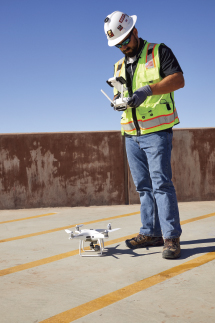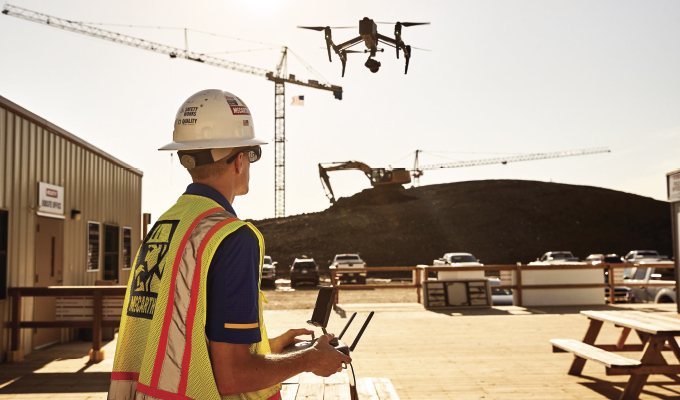In the construction industry, employees are exposed to some of the most physically demanding work environments. This is only exacerbated by potential harsh weather conditions on jobsites around the country. Through embracing technology, we can help reduce the number of exposures to potential hazards, monitor worker and environmental conditions, and plan work accordingly.
DRONE INTEGRATION
The use of drones on construction projects isn’t new, but they have recently become more of a contributor to McCarthy’s approach to improving workplace safety. Drones can serve as a safe substitute for humans in undertaking hazardous tasks. Although we use drones across the company, we have found specialized uses for them in a few of our different work programs.
In our commercial market, drones are employed to review elevated work such as routine building enclosure inspections. This task would otherwise require mobile elevated work platforms or scaffolding to complete these inspections. Although these traditional methods are still used, the frequency is decreasing. This translates to less need for additional equipment and fewer potential fall hazards.
In the self-perform civil market, drones complete topographical survey over large swaths of land and even calculate the slopes of excavations. We have found the use of drones to be much safer and more effective for completing this type of work compared to the old way of using heavy surveying equipment. The ability of drones to access hard-to-reach locations provides a faster and more accurate report and provides both a time and cost savings over traditional surveying techniques.
On our renewable energy projects sites, drones identify faulty solar panel modules. In lieu of having crews troubleshoot and search to find deficient modules, a drone affixed with a thermal camera can quickly find varying heat signatures indicating an issue. This has dramatically increased our efficiency. More importantly, in this role, drones reduce our crew’s exposure to electrical hazards associated with panel troubleshooting as well as the thermal exposure working around modules.

WEARABLE TECHNOLOGY
With OSHA’s Heat Illness Prevention Campaign and the CDC’s staggering statistics that more than 650 fatal injuries occur each year due to heat related illness (HRI), McCarthy strives to protect employees and trade partners from HRI on projects.
We rely on jobsite data to improve management, and McCarthy is first in line to evaluate new HRI-related technologies. McCarthy partnered with Kenzen in 2021 to pilot wearable heat monitoring technology on multiple construction projects in Arizona, Georgia, and Texas. The Kenzen device—worn on the employees’ bicep—contains sensors to monitor external environmental conditions as well as the employees’ vitals in real time. The program uses an 11-question medical survey to take the guesswork out of HRI and personalize it to the employee. This confidential questionnaire focuses on medical and personal history that could affect the employee’s susceptibility to HRI. The device uses the employee’s personal information in conjunction with the information collected by the wearables’ sensors to produce real-time HRI data.
The capability to provide personalized data allows employees to better understand the importance of proper hydration, core body temperature, and sweat rate as it relates to their body. Most beneficial to the education and training of our employees was the stop work alerts generated by an algorithm built into the wearable. This notification alerted the employee and their supervisor of dangerous heat stress symptoms when their core body temperature and/or heart rate became elevated. This feature was seen by the employees as a tool to tailor the way they work. Over the 10-week pilot, crews were able to modify their work practices to reduce the number of stop work alerts that occurred by working at a more constant pace rather than short bursts of high output energy.
Overall, the data collected by the pilot program was compiled and analyzed using an analytics dashboard. This valuable information has helped McCarthy to identify new ways to prevent heat illness as well as assist to validate current practices to ensure employees are educated with the best possible programs and resources.
CLOSING THOUGHT
The advancement of technology within the construction industry is seen throughout the building process but innovation employed in the name of safety is the most important.
About the Author:
Andrew Rhines, GSP, CHST is a project safety manager for McCarthy Building Companies, Inc.’s Southern Region. For more, visit www.mccarthy.com.
Modern Contractor Solutions, July 2023
Did you enjoy this article?
Subscribe to the FREE Digital Edition of Modern Contractor Solutions magazine.



